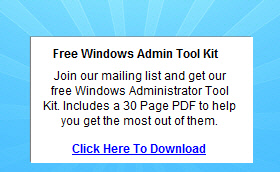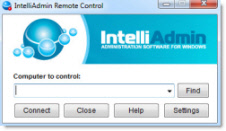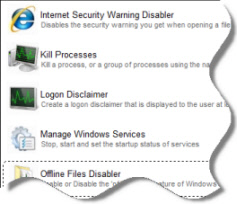Using PowerShell to Set DCOM Permissions for FIM Self-Service Password Reset
Summary
Setting the DCOM permissions is a bit tedious and prone to error, especially if you have multiple environments and both a primary and standby server to configure.
This little script is provided as a way to simplify your deployment of FIM Self-Service Password Reset configuration tasks.
Note
See also the script for
setting WMI permissions.
PARAM(
[string]$Principal = $(throw "`nMissing -Principal DOMAIN\FIM PasswordSet"),
$Computers = $(throw "`nMissing -Computers ('fimnode01','fimnode02')"))
# USAGE:
#
# .\Set-FIM-DCOM.ps1 -Principal "DOMAIN\<group or username>" -Computers ('<server1>', '<server2>',...)
#
# EXAMPLE:
# .\Set-FIM-DCOM.ps1 -Principal "DOMAIN\FIM PasswordSet" -Computers ('fimsyncprimary', 'fimsyncstandby')
#
# Inspired by Karl Mitschke's post:
# http://unlockpowershell.wordpress.com/2009/11/20/script-remote-dcom-wmi-access-for-a-domain-user/
Write-Host "Set-FIM-DCOM - Updates DCOM Permissions for FIM Password Reset"
Write-Host "`tWritten by Brad Turner (bturner@ensynch.com)"
Write-Host "`tBlog: http://www.identitychaos.com"
function get-sid
{
PARAM ($DSIdentity)
$ID = new-object System.Security.Principal.NTAccount($DSIdentity)
return $ID.Translate( [System.Security.Principal.SecurityIdentifier] ).toString()
}
$sid = get-sid $Principal
#MachineLaunchRestriction - Local Launch, Remote Launch, Local Activation, Remote Activation
$DCOMSDDLMachineLaunchRestriction = "A;;CCDCLCSWRP;;;$sid"
#MachineAccessRestriction - Local Access, Remote Access
$DCOMSDDLMachineAccessRestriction = "A;;CCDCLC;;;$sid"
#DefaultLaunchPermission - Local Launch, Remote Launch, Local Activation, Remote Activation
$DCOMSDDLDefaultLaunchPermission = "A;;CCDCLCSWRP;;;$sid"
#DefaultAccessPermision - Local Access, Remote Access
$DCOMSDDLDefaultAccessPermision = "A;;CCDCLC;;;$sid"
#PartialMatch
$DCOMSDDLPartialMatch = "A;;\w+;;;$sid"
foreach ($strcomputer in $computers)
{
write-host "`nWorking on $strcomputer with principal $Principal ($sid):"
# Get the respective binary values of the DCOM registry entries
$Reg = [WMIClass]"\\$strcomputer\root\default:StdRegProv"
$DCOMMachineLaunchRestriction = $Reg.GetBinaryValue(2147483650,"software\microsoft\ole","MachineLaunchRestriction").uValue
$DCOMMachineAccessRestriction = $Reg.GetBinaryValue(2147483650,"software\microsoft\ole","MachineAccessRestriction").uValue
$DCOMDefaultLaunchPermission = $Reg.GetBinaryValue(2147483650,"software\microsoft\ole","DefaultLaunchPermission").uValue
$DCOMDefaultAccessPermission = $Reg.GetBinaryValue(2147483650,"software\microsoft\ole","DefaultAccessPermission").uValue
# Convert the current permissions to SDDL
write-host "`tConverting current permissions to SDDL format..."
$converter = new-object system.management.ManagementClass Win32_SecurityDescriptorHelper
$CurrentDCOMSDDLMachineLaunchRestriction = $converter.BinarySDToSDDL($DCOMMachineLaunchRestriction)
$CurrentDCOMSDDLMachineAccessRestriction = $converter.BinarySDToSDDL($DCOMMachineAccessRestriction)
$CurrentDCOMSDDLDefaultLaunchPermission = $converter.BinarySDToSDDL($DCOMDefaultLaunchPermission)
$CurrentDCOMSDDLDefaultAccessPermission = $converter.BinarySDToSDDL($DCOMDefaultAccessPermission)
# Build the new permissions
write-host "`tBuilding the new permissions..."
if (($CurrentDCOMSDDLMachineLaunchRestriction.SDDL -match $DCOMSDDLPartialMatch) -and ($CurrentDCOMSDDLMachineLaunchRestriction.SDDL -notmatch $DCOMSDDLMachineLaunchRestriction))
{
$NewDCOMSDDLMachineLaunchRestriction = $CurrentDCOMSDDLMachineLaunchRestriction.SDDL -replace $DCOMSDDLPartialMatch, $DCOMSDDLMachineLaunchRestriction
}
else
{
$NewDCOMSDDLMachineLaunchRestriction = $CurrentDCOMSDDLMachineLaunchRestriction.SDDL += "(" + $DCOMSDDLMachineLaunchRestriction + ")"
}
if (($CurrentDCOMSDDLMachineAccessRestriction.SDDL -match $DCOMSDDLPartialMatch) -and ($CurrentDCOMSDDLMachineAccessRestriction.SDDL -notmatch $DCOMSDDLMachineAccessRestriction))
{
$NewDCOMSDDLMachineAccessRestriction = $CurrentDCOMSDDLMachineAccessRestriction.SDDL -replace $DCOMSDDLPartialMatch, $DCOMSDDLMachineLaunchRestriction
}
else
{
$NewDCOMSDDLMachineAccessRestriction = $CurrentDCOMSDDLMachineAccessRestriction.SDDL += "(" + $DCOMSDDLMachineAccessRestriction + ")"
}
if (($CurrentDCOMSDDLDefaultLaunchPermission.SDDL -match $DCOMSDDLPartialMatch) -and ($CurrentDCOMSDDLDefaultLaunchPermission.SDDL -notmatch $DCOMSDDLDefaultLaunchPermission))
{
$NewDCOMSDDLDefaultLaunchPermission = $CurrentDCOMSDDLDefaultLaunchPermission.SDDL -replace $DCOMSDDLPartialMatch, $DCOMSDDLDefaultLaunchPermission
}
else
{
$NewDCOMSDDLDefaultLaunchPermission = $CurrentDCOMSDDLDefaultLaunchPermission.SDDL += "(" + $DCOMSDDLDefaultLaunchPermission + ")"
}
if (($CurrentDCOMSDDLDefaultAccessPermission.SDDL -match $DCOMSDDLPartialMatch) -and ($CurrentDCOMSDDLDefaultAccessPermission.SDDL -notmatch $DCOMSDDLDefaultAccessPermision))
{
$NewDCOMSDDLDefaultAccessPermission = $CurrentDCOMSDDLDefaultAccessPermission.SDDL -replace $DCOMSDDLPartialMatch, $DCOMSDDLDefaultAccessPermision
}
else
{
$NewDCOMSDDLDefaultAccessPermission = $CurrentDCOMSDDLDefaultAccessPermission.SDDL += "(" + $DCOMSDDLDefaultAccessPermision + ")"
}
# Convert SDDL back to Binary
write-host "`tConverting SDDL back into binary form..."
$DCOMbinarySDMachineLaunchRestriction = $converter.SDDLToBinarySD($NewDCOMSDDLMachineLaunchRestriction)
$DCOMconvertedPermissionsMachineLaunchRestriction = ,$DCOMbinarySDMachineLaunchRestriction.BinarySD
$DCOMbinarySDMachineAccessRestriction = $converter.SDDLToBinarySD($NewDCOMSDDLMachineAccessRestriction)
$DCOMconvertedPermissionsMachineAccessRestriction = ,$DCOMbinarySDMachineAccessRestriction.BinarySD
$DCOMbinarySDDefaultLaunchPermission = $converter.SDDLToBinarySD($NewDCOMSDDLDefaultLaunchPermission)
$DCOMconvertedPermissionDefaultLaunchPermission = ,$DCOMbinarySDDefaultLaunchPermission.BinarySD
$DCOMbinarySDDefaultAccessPermission = $converter.SDDLToBinarySD($NewDCOMSDDLDefaultAccessPermission)
$DCOMconvertedPermissionsDefaultAccessPermission = ,$DCOMbinarySDDefaultAccessPermission.BinarySD
# Apply the changes
write-host "`tApplying changes..."
if ($CurrentDCOMSDDLMachineLaunchRestriction.SDDL -match $DCOMSDDLMachineLaunchRestriction)
{
write-host "`t`tCurrent MachineLaunchRestriction matches desired value."
}
else
{
$result = $Reg.SetBinaryValue(2147483650,"software\microsoft\ole","MachineLaunchRestriction", $DCOMbinarySDMachineLaunchRestriction.binarySD)
if($result.ReturnValue='0'){write-host " Applied MachineLaunchRestricition complete."}
}
if ($CurrentDCOMSDDLMachineAccessRestriction.SDDL -match $DCOMSDDLMachineAccessRestriction)
{
write-host "`t`tCurrent MachineAccessRestriction matches desired value."
}
else
{
$result = $Reg.SetBinaryValue(2147483650,"software\microsoft\ole","MachineAccessRestriction", $DCOMbinarySDMachineAccessRestriction.binarySD)
if($result.ReturnValue='0'){write-host " Applied MachineAccessRestricition complete."}
}
if ($CurrentDCOMSDDLDefaultLaunchPermission.SDDL -match $DCOMSDDLDefaultLaunchPermission)
{
write-host "`t`tCurrent DefaultLaunchPermission matches desired value."
}
else
{
$result = $Reg.SetBinaryValue(2147483650,"software\microsoft\ole","DefaultLaunchPermission", $DCOMbinarySDDefaultLaunchPermission.binarySD)
if($result.ReturnValue='0'){write-host " Applied DefaultLaunchPermission complete."}
}
if ($CurrentDCOMSDDLDefaultAccessPermission.SDDL -match $DCOMSDDLDefaultAccessPermision)
{
write-host "`t`tCurrent DefaultAccessPermission matches desired value."
}
else
{
$result = $Reg.SetBinaryValue(2147483650,"software\microsoft\ole","DefaultAccessPermission", $DCOMbinarySDDefaultAccessPermission.binarySD)
if($result.ReturnValue='0'){write-host " Applied DefaultAccessPermission complete."}
}
}
#----------------------------------------------------------------------------------------------------------
trap
{
$exMessage = $_.Exception.Message
if($exMessage.StartsWith("L:"))
{write-host "`n" $exMessage.substring(2) "`n" -foregroundcolor white -backgroundcolor darkblue}
else {write-host "`nError: " $exMessage "`n" -foregroundcolor white -backgroundcolor darkred}
Exit
}
#----------------------------------------------------------------------------------------------------------
Go to the FIM ScriptBox
Brad Turner, ILM MVP - Ensynch, Inc - www.identitychaos.com
June 13th, 2010 3:08am
Awesome! Does this work for both Windows Server 2008 and R2? Does it solve the issue solved by
http://www.wictorwilen.se/Post/Post.aspx?id=492? If so will it still work for Windows Server 2008?David Lundell www.ilmBestPractices.com
Free Windows Admin Tool Kit Click here and download it now
June 24th, 2010 12:57am
David, it does not fix the DCOM error in the reference article, it just sets permissions required for password reset withing DCOM.Brad Turner, ILM MVP - Ensynch, Inc - www.identitychaos.com [If a post helps to resolve your issue, please click the "Mark as Answer" or "Helpful" button at the top of that post. By marking a post as Answered or Helpful, you help others
find the answer faster.]
February 13th, 2011 9:47pm
I received the following error after running the script, any ideas on what might be casusing that?
Error: Cannot convert value "\\<fim>\root\default:StdRegProv" to type "System.Management.ManagementClass". Error: "The
RPC server is unavailable. (Exception from HRESULT: 0x800706BA)"
I'm trying to run this on Server 2008 R2
Free Windows Admin Tool Kit Click here and download it now
April 13th, 2011 10:57am
Abraham,
You are likely encountering a connectivity or firewall issue due to the "RPC Server is unavailable" error. I would ensure that you can resolve the system, and be able to access the registry remotely.Brad Turner - www.identitychaos.com [If a post helps to resolve your issue, please click the "Mark as Answer" or "Helpful" button at the top of that post. By marking a post as Answered or Helpful, you help others find the answer faster.]
April 13th, 2011 2:29pm
Thanks for the reply. Turns out it was was syntax error on my part.
Free Windows Admin Tool Kit Click here and download it now
April 14th, 2011 7:43am


